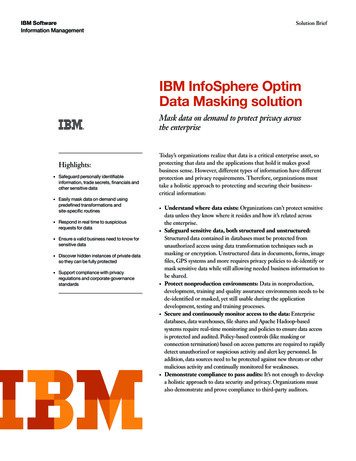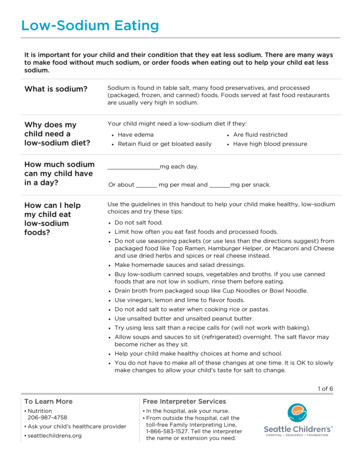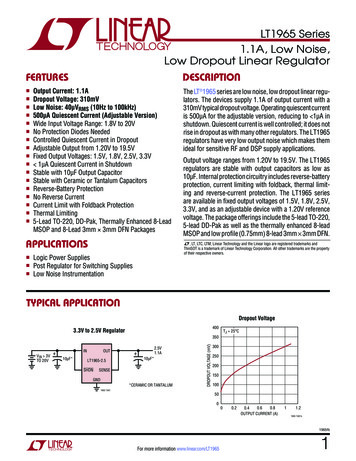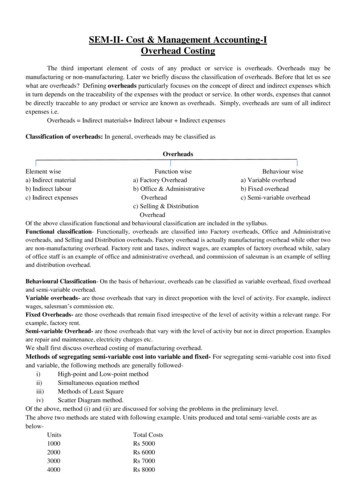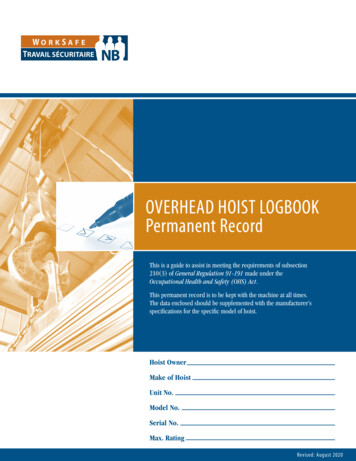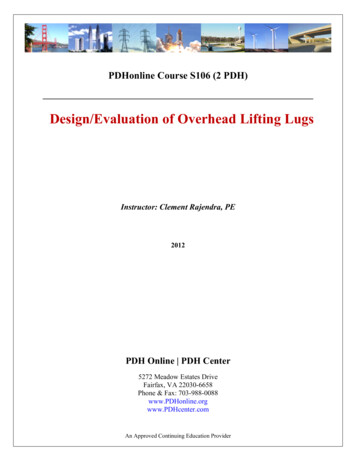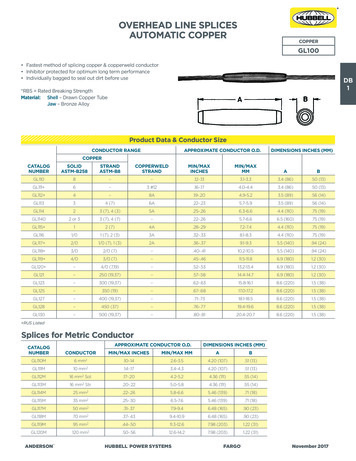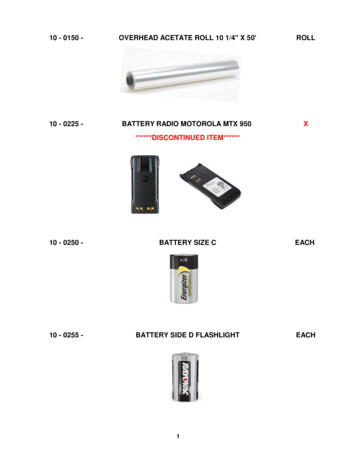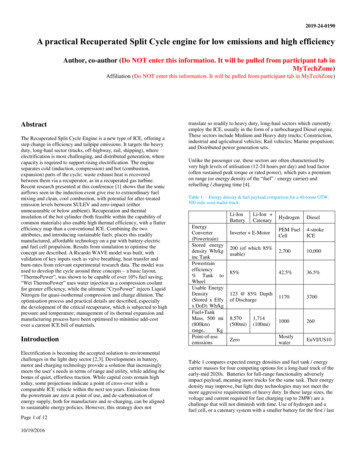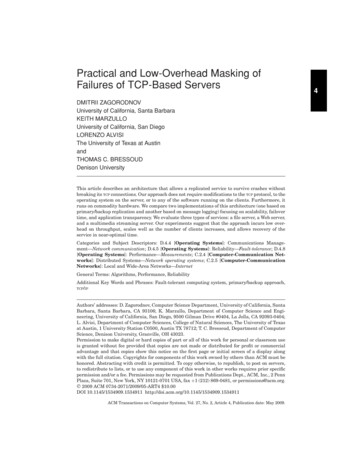
Transcription
Practical and Low-Overhead Masking ofFailures of TCP-Based ServersDMITRII ZAGORODNOVUniversity of California, Santa BarbaraKEITH MARZULLOUniversity of California, San DiegoLORENZO ALVISIThe University of Texas at AustinandTHOMAS C. BRESSOUDDenison UniversityThis article describes an architecture that allows a replicated service to survive crashes withoutbreaking its TCP connections. Our approach does not require modifications to the TCP protocol, to theoperating system on the server, or to any of the software running on the clients. Furthermore, itruns on commodity hardware. We compare two implementations of this architecture (one based onprimary/backup replication and another based on message logging) focusing on scalability, failovertime, and application transparency. We evaluate three types of services: a file server, a Web server,and a multimedia streaming server. Our experiments suggest that the approach incurs low overhead on throughput, scales well as the number of clients increases, and allows recovery of theservice in near-optimal time.Categories and Subject Descriptors: D.4.4 [Operating Systems]: Communications Management—Network communication; D.4.5 [Operating Systems]: Reliability—Fault-tolerance; D.4.8[Operating Systems]: Performance—Measurements; C.2.4 [Computer-Communication Networks]: Distributed Systems—Network operating systems; C.2.5 [Computer-CommunicationNetworks]: Local and Wide-Area Networks—InternetGeneral Terms: Algorithms, Performance, ReliabilityAdditional Key Words and Phrases: Fault-tolerant computing system, primary/backup approach,TCP/IPAuthors’ addresses: D. Zagorodnov, Computer Science Department, University of California, SantaBarbara, Santa Barbara, CA 93106; K. Marzullo, Department of Computer Science and Engineering, University of California, San Diego, 9500 Gilman Drive #0404, La Jolla, CA 92093-0404;L. Alvisi, Department of Computer Sciences, College of Natural Sciences, The University of Texasat Austin, 1 University Station C0500, Austin TX 78712; T. C. Bressoud, Department of ComputerScience, Denison University, Granville, OH 43023.Permission to make digital or hard copies of part or all of this work for personal or classroom useis granted without fee provided that copies are not made or distributed for profit or commercialadvantage and that copies show this notice on the first page or initial screen of a display alongwith the full citation. Copyrights for components of this work owned by others than ACM must behonored. Abstracting with credit is permitted. To copy otherwise, to republish, to post on servers,to redistribute to lists, or to use any component of this work in other works requires prior specificpermission and/or a fee. Permissions may be requested from Publications Dept., ACM, Inc., 2 PennPlaza, Suite 701, New York, NY 10121-0701 USA, fax 1 (212) 869-0481, or permissions@acm.org. C 2009 ACM 0734-2071/2009/05-ART4 10.00DOI 10.1145/1534909.1534911 http://doi.acm.org/10.1145/1534909.1534911ACM Transactions on Computer Systems, Vol. 27, No. 2, Article 4, Publication date: May 2009.4
4:2 D. Zagorodnov et al.ACM Reference Format:Zagorodnov, D., Marzullo, K., Alvisi, L., and Bressoud, T. C. 2009. Practical and low-overheadmasking of failures of TCP-based servers. ACM Trans. Comput. Syst. 27, 2, Article 4 (May 2009),39 pages. DOI 10.1145/1534909.1534911 http://doi.acm.org/10.1145/ 1534909.15349111. INTRODUCTIONis the most popular transport-layer protocol in use today and a diverse setof network services has been built on top of it. It is used for short sessionssuch as HTTP connections, for longer sessions that involve large data transfers,and for continuous sessions like those used by the interdomain routing protocolBGP. As more people come to rely on network services, the issue of reliabilityhas become pressing. To ensure reliable service, failures of the service endpointmust be tolerated.Many companies marketing high-end server hardware—IBM, Sun, HP, Veritas, Integratus—offer fault-tolerant solutions for TCP-based servers. The solutions are usually built using a cluster of servers interconnected with a fastprivate network which is used for access to shared disks, for replica coordination, and for failure detection. When a server in the cluster fails, all ongoingconnections to that server break. The failover mechanism ensures that if aclient attempts to reopen a connection, then it will be directed to a healthyserver. Although this client-assisted recovery is adequate for some services, itis often desirable to hide server failures from clients.When the client base is large and diverse, the organization running the service may lack control over the client host configuration and the applicationsrunning on the host. This means that client applications often cannot be expected to assist in the failover of the service. Such is the situation with manyInternet services, where servers and clients are written by different people andprovisions for fault tolerance in the application-level protocol do not exist. Convincing one’s business clients or partners to upgrade to a new protocol is oftennot an option.Consider a popular file server, Samba [SMB 2005]: If the server fails, alltransfers are aborted and the user must explicitly restart any outstandingtransactions. Although the protocol allows aborted transfers to be restarted,many clients, such as Windows Explorer, choose not to do this, entailing retransmission of entire files. Similarly, typical media streaming clients, suchas Apple’s QuickTime Player, do not attempt to restart aborted sessions, whichmeans users can miss sections of live broadcasts even if they restart the streammanually. Web browsers do not hide server errors or failures by design; a partialHTTP response is rendered either as an error or as an incomplete Web page, depending on how much data the browser received. Often a transient Web serverfailure can be solved by the user pressing the browser’s “reload” button; however, a server failing in the middle of a financial transaction can leave the userunsure whether the transaction took place or not. These are all examples ofuser irritations that a service provider may want to avoid.In this article we describe a system called fault-tolerant TCP ( FT-TCP). Thissystem allows a faulty server to keep its TCP connections open until it eitherTCPACM Transactions on Computer Systems, Vol. 27, No. 2, Article 4, Publication date: May 2009.
Practical and Low-Overhead Masking of Failures of TCP-Based Servers 4:3recovers or is failed over to a backup. In either case, both the failure and recoveryof the server are completely transparent to clients connected to it via TCP. FT-TCPdoes not require any changes to the client software, does not require changes tothe TCP protocol, and does not use a proxy in the middle of the network; all faulttolerance logic is constrained to the server cluster. Furthermore, because thesystem has been designed in the form of “wrappers” around kernel components,no changes to the TCP stack implementation on the server are required, whilethe required changes to server applications are small.We have evaluated the performance of FT-TCP both with a synthetic application designed to obtain maximum throughput of TCP, as well as withseveral real-world services, such as Samba [SMB 2005], Darwin StreamingServer [DSS 2005], and the Apache [2005] Web server. FT-TCP supports two common application-level replication methods: primary-backup [Budhiraja et al.1992] and message-logging [Elnozahy et al. 2002]. In our experiments, we foundtheir failure-free performance statistically indistinguishable. Neither one incurred significant overhead on connection throughput for bulk transfers, whiletheir effect on latency depends on the client request traffic: With many smallrequests from few clients, the overhead is large, but as either the request sizeor the number of clients grows, the overhead diminishes to the point of insignificance. We also found that with primary-backup the failover time of FT-TCP canbe made short, but to do so the backup must aggressively capture client data.The remainder of this article is organized as follows. We cover the background material relevant to this work in Section 2. We offer an overview of thegeneral structure of our system (primary-backup as well as message-loggingversions) in Section 3, while Sections 4–6 present FT-TCP in greater detail. InSection 7 we describe the three applications we use to evaluate the system.The performance discussion is divided in two parts: In Section 8 we discussthe overhead of FT-TCP in terms of throughput and latency, and in Section 9 welook at the dynamics of connection failover. We compare FT-TCP to other possible approaches and alternative systems in Section 10. Finally, we draw ourconclusions in Section 11.2. BACKGROUNDIn this section, we introduce two concepts that are relevant to the discussion ofservice failover: operation of TCP and fault tolerance fundamentals.2.1 TCP Overviewimplements a bidirectional byte stream by fragmenting data into segmentsand by sending each one in a packet with its own header. (The maximum size ofthe segment is limited to 40 bytes less than the Maximum Transmission Unit,or MTU, of the path between the sender and the receiver, which is usually 1500bytes long, making the typical maximum segment size 1460 bytes.) The headercarries control data, implementing error recovery, flow control, and congestioncontrol.To this end, the header carries two sequence numbers, one for each direction.When a connection is established, each connection endpoint selects a randomTCPACM Transactions on Computer Systems, Vol. 27, No. 2, Article 4, Publication date: May 2009.
4:4 D. Zagorodnov et al.32-bit integer to serve as its initial sequence number (isn) that is logically associated with an imaginary byte 0 in the data stream. Consequently, an actualbyte number n (where n 1) in the stream is associated with the sequencenumber (isn n) mod 232 . The modulo operation accounts for the sequencenumber wraparound that occurs when the number exceeds the capacity of a32-bit integer. Every header contains the sequence number of the first byte inthe segment that the packet carries, allowing the receiver to sequence that segment relative to all other segments regardless of the order in which they arrive.Duplicates are likewise detected and ignored.TCP connections are established with the help of binary flags in the packetheader. A client initiates the connection by sending to the server a packet withthe SYN flag set and with a randomly chosen sequence number isnc . If the serveraccepts the connection (i.e., the server is willing and able to proceed with thisclient) it replies back with a packet that has both the SYN and ACK flags set andcontains a proposed isns for the server as well as the TCP header acknowledgment number field, set to isnc 1. Outgoing acknowledgment numbers are set tothe sequence number of the byte following the last contiguous byte the receivergot from the sender, thereby indicating what data have been received. We calla packet that acknowledges data but does not carry any data an ACK packet, orsimply an ACK. Finally, the client replies with an ACK packet with acknowledgment number set to isns 1, at which point both sides consider the connectionestablished. This protocol is known as a three-way handshake. We call the bytestream from the client to the server the instream and the byte stream from theserver to the client the outstream.To implement flow control, the TCP header carries a 16-bit window size field,which indicates to the sender how much buffer space is available on the receiver.If, for example, the advertised window is 16KB, then the sender can send up toeleven 1460-byte segments before stalling in wait for an acknowledgment. Thewindow size is used for flow control: If the receiver is not able to process theincoming segments fast enough, the window shrinks and may eventually reachzero, at which point the sender refrains from sending any more segments. Asthe receiver consumes the buffered segments, its buffers free up and the windowincreases in size, allowing the sender to resume sending data.To implement a reliable stream, TCP must deal with dropped or corruptedpackets. A checksum of the whole packet enables TCP to identify corruptedpackets and discard them. The acknowledgment number tells the client whenpackets are dropped using a cumulative acknowledgment scheme. For example,in a situation where packets A, B, and C are sent and packet B gets dropped,the receiver will acknowledge only A even after it receives C. Eventually, a retransmission timer will expire on the sender, which will then resend B, thusfilling the gap and causing the receiver to acknowledge all three packets byacknowledging packet C.2.2 Replication ConceptsRecovery of a network service is possible when every connection is backed bysome number of server replicas: a primary server and at least one backup.ACM Transactions on Computer Systems, Vol. 27, No. 2, Article 4, Publication date: May 2009.
Practical and Low-Overhead Masking of Failures of TCP-Based Servers 4:5Should the primary fail, all backups must have the information needed to takeover the role of the primary as endpoint in its ongoing connections. A backupis said to be promoted when it is chosen to become the next primary. FT-TCPsupports two approaches to coordinating replicas.In the first approach, called primary-backup [Budhiraja et al. 1992], everyreplica performs the processing of client requests; when all replicas have completed processing, one of them (the primary) replies. If the primary fails, oneof the backup replicas is promoted. In the second approach, called messagelogging [Elnozahy et al. 2002], only one replica is actively processing requestsand all requests from the client are saved in a log that is guaranteed to survivefailures. Just as in the first approach, the primary does not reply to the clientuntil it is assured that all prior requests have been logged. If a failure occurs,another replica is started. This replica replays messages from the log to bringitself to the prefailure state of the primary, at which point the replica is promoted. If periodic checkpoints are taken, then only the messages that arrivedsince the most recent checkpoint need to be replayed.In this article, we refer to these two approaches as hot backup and coldbackup. In both approaches the primary waits before replying to a client untilit is assured that the backup can be recovered to the primary’s current state.This is commonly called the output commit problem [Elnozahy et al. 2002]. Wehenceforth refer to these forced waiting periods as output commit stalls. When abackup takes over, it does not know whether the primary failed before or afterreplying to the client (this is a fundamental limitation of any fault-tolerantsystem). Fortunately, TCP was designed to deal with duplicate packets, so whenin doubt the backup can safely resend the reply.For both hot and cold backups, the process execution paths of the primaryand the backups must match. If they do not, then a backup may never reach thestate of the primary and therefore will not be able to take over the connection. If,for example, a system call returns different values on the primary and a backupreplica, the execution paths of these processes may diverge. To accommodatethis possibility, in addition to capturing client requests, we also intercept systemcalls on all replicas, save the primary’s system call results in a log, and returnthose values as the results of the corresponding system calls on the replicas.We discuss further how we deal with this and other sources of nondeterminismin Section 5.3. ARCHITECTURE OVERVIEWFT-TCPenables connection failover for Internet services that is transparent tothe client and requires no changes to the TCP protocol or to the operating systemrunning on the server. The key idea is that, by logging incoming network dataas well as the information that the service process receives from the operatingsystem, a replica of the service can be created on backup machines and, if necessary, substituted for the original service without breaking its TCP connections.To avoid changes to the operating system, FT-TCP is implemented by “wrapping” the TCP/IP stack. By this, we mean that FT-TCP can intercept, modify, and discard packets between the TCP/IP stack and the network driver using a componentACM Transactions on Computer Systems, Vol. 27, No. 2, Article 4, Publication date: May 2009.
4:6 D. Zagorodnov et al.Fig. 1. FT-TCP architecture.we call the south-side wrapper or SSW. Also, FT-TCP can intercept and change thesemantics of system calls (between application and kernel) made by the serverapplication using a component we call the north-side wrapper or NSW. Althoughthe wrappers are kernel-level components, they require no changes to the operating system and, in our implementation, can be loaded into and unloadedfrom a standard kernel dynamically, without a recompilation or a reboot. Boththe NSW and the SSW on the primary replica communicate with a stable bufferthat is designed to survive failures.In our implementation, the stable buffer is located in the physical memoryof the backup machines, but other approaches, such as saving data on disk orin nonvolatile memory, are also possible. In addition to logging data, a stablebuffer can acknowledge the data elements it receives, as well as return themto a requester in FIFO order. When we call a datum stable, we mean that it hasbeen acknowledged by the stable buffer and will therefore survive a failure.In the rest of the article we will use a setup with a single backup and a singlestable buffer, colocated with that backup, as shown in Figure 1. Our techniquecan be extended to use any number of backup hosts by modifying the stablebuffer protocol to use reliable broadcast and by ensuring that, during failover,all backups elect the same primary. Furthermore, in the discussion that follows,although we may talk of one server process or one connection, FT-TCP supportsmultiple concurrent processes and concurrent connections, possibly to a singleprocess, and tolerates the failure of the primary as well as of any number of thereplicas—as long as, of course, at least one backup replica continues to operatecorrectly.3.1 Failure-Free OperationFT-TCPbegins interception either when a network service application that it isdesignated to protect begins execution or when the first client packet for thatACM Transactions on Computer Systems, Vol. 27, No. 2, Article 4, Publication date: May 2009.
Practical and Low-Overhead Masking of Failures of TCP-Based Servers 4:7service arrives from the network, whichever happens first. (The latter is the casewhen the service application is invoked by a metaserver, such as inetd.) Duringa run without failures, the SSW on the primary sends incoming packets to thestable buffer. The primary’s NSW does the same with the results of system callsinvoked by each thread of the server application. In the cold-backup scheme, thewraps on the backup replica are idle (they will be activated only if a failover isnecessary), so the only activities performed by the backup machine are loggingand monitoring of the health of the primary replica.In the hot-backup scheme, in addition to logging and monitoring, the backupis executing the same server application binary as the one running on the primary. To this process the NSW “feeds” the contents of the stable buffer. Specifically, the NSW ensures that the backup process receives the same results fromits system calls as does the primary process. In particular, this includes the recvcall for receiving network input, which the NSW extracts from the packets in thestable buffer. The role of the SSW on the backup during failure-free operation islimited to spoofing incoming client connections so that the backup’s TCP stackallocates state for them.3.2 FailoverA failure of the primary is detected by the backup based on the absence of communication by the primary for an interval of time (see Section 9 for additionaldetails on failure detection and recovery durations). Once the failure is detected,the backup initiates failover, which proceeds differently for the hot-backup andthe cold-backup schemes.In the hot-backup scheme, the backup replica already has a server processthat has been following the execution path of the server process on the failedprimary. Thus, after the backup process “catches up” to where the primary process was just before the failure (by consuming all remaining TCP segments andsystem call records in the stable buffer), it can take over the open connection.The failover completes with the backup machine being promoted to a primary.To enable the backup to impersonate the failed primary to the clients, the SSWacts to reconcile the externally visible differences in the TCP state between theold primary and the new one.One such difference is the IP address. In our implementation, the SSW switchesthe backup’s real IP address for the old primary’s address on all outgoing packetsand performs the reverse on all the incoming client packets, effectively functioning as a network address translation (NAT) unit [Srisuresh and Holdrege1999]. To gain access to all incoming packets (that are destined to a different MAC address), we place the network interface card into promiscuous mode.When using a switched hub for connecting replicas to the client, the hub mustbe configured to direct client packets to all replicas. If some other technique forpermanently changing the IP address of the entire host is used (e.g., by using agratuitous ARP [Bhide et al. 1991] or a physically separate address translatingswitch), then using promiscuous mode may not be necessary.The other difference in TCP connection state between the primary and thebackup is in the sequence numbers they use. The TCP connection on the backupACM Transactions on Computer Systems, Vol. 27, No. 2, Article 4, Publication date: May 2009.
4:8 D. Zagorodnov et al.is idle during normal operation (since all the data are injected through theNSW), so its sequence numbers stay at their initial values. After failover thesequence numbers must be adjusted by the SSW on all packets as follows: Incoming sequence numbers are shifted by the number of bytes the primary readbefore failure and the outgoing ones are adjusted by the difference between thebackup’s initial sequence number and the sequence number of the last byte theprimary sent to the client.Failover with a cold backup essentially consists of redoing the actions performed by a hot backup during normal operation followed by the actions performed by it during failover. First, a new server process is started on the backuphost and a connection to it is spoofed by the SSW (in the case of a metaservice, such as inetd, the spoofing of the connection will cause the creation of anew server process). This process then “consumes” buffered packets and systemcalls, and eventually takes over the connection after the IP address and sequencenumber adjustments described earlier. Since rolling the process forward takestime, failover with a cold backup can take substantially longer than with a hotbackup. Recovery from a cold backup can be sped up significantly by addinga checkpointing mechanism to FT-TCP; however, checkpointing the state of theserver application is outside of the scope of this article, henceforth, we assumethat a restarting server has the application restart from its initial state.Failure of the backup is detected by the primary based on the absence ofacknowledgments from the backup for an interval of time. Henceforth, the failedbackup does not cause any further output commit stalls at the primary.During failover, it is important to prevent connection timeouts and the appearance of a nonresponsive server. In FT-TCP, a separate component keeps clientconnections alive by responding to their segments with an ACK packet that has awindow of size 0. This gives clients the illusion that the server is still viable, butalso does not allow them to send any more data while the service is recovering.4. ARCHITECTURE DETAILSIn this section, we describe the operation of FT-TCP in detail. After introducingthe state maintained by FT-TCP, we describe the activities of the wrappers indifferent modes of operation.4.1 StateFT-TCPmaintains the following variables for each ongoing connection.—idelta- seq and odelta- seq: the deltas (for instream and outstream) betweenthe sequence numbers in use by the client and the sequence numbers apparent to the TCP stack at the server. Upon recovery, these variables allow theSSW to map sequence numbers between the server’s TCP layer and the client’sTCP layer for the instream and outstream.— stable- seq: the smallest sequence number of the instream that has not yetbeen acknowledged by the stable buffer to the SSW. The value of stable- seq cannever be larger (ignoring the 32-bit wrap) than the largest sequence numberACM Transactions on Computer Systems, Vol. 27, No. 2, Article 4, Publication date: May 2009.
Practical and Low-Overhead Masking of Failures of TCP-Based Servers 4:9Table I. Summary of the Key Variables Used by FT-TCPVariableidelta- seqodelta- seqstable- seqserver- seqsyscall- idunstable- syscallsUpdatedat TCP’s 3-way handshakeat TCP’s 3-way handshakefrom St. Buffer’s callbackoutstream seq. numbersat sys. callat sys. call & St. Buffer’s callbackRelated toinstream seq. numbersoutstream seq. numbersfrom instream packetsinstream seq. numberstotal # of sys. calls# of unstable sys. callsThese key variables include when they are set and what quantities in the system they arerelated to.that the server has received from the client. During recovery, this value canbe computed from the data stored in the stable buffer.— server- seq: the highest sequence number of the outstream acknowledged bythe client and seen by the SSW. This value also can be computed during recovery from the data stored in the stable buffer.FT-TCPmaintains the following variables for each thread of execution of theserver. (A single-threaded server has a single instance of each of thesevariables.)—syscall- id: the count of the number of system calls made by the thread. Thisvalue servers as an identifier for system calls. With this ID, calls made by theprimary and the backup can be matched.— unstable- syscalls: the count of the number of system calls whose records havenot been acknowledged by the stable buffer. If unstable- syscalls is 0, then thestable buffer has recorded the results of all prior system calls.The six variables introduced so far are summarized in Table I, which stateswhen the variables are initialized and possibly updated by FT-TCP (through aprocess that will be explained in the following sections) and whether they referto instreams or outstreams or system call counts.To make the description of FT-TCP inner workings more precise (and, in particular, to demonstrate that hot and cold replication schemes are based on thesame mechanisms) we group the actions of the system components (for eachreplicated service) into three modes.(1) STANDBY MODE. In this mode the wraps are idle, while the stable bufferperforms logging. Cold backups are started in STANDBY MODE and stay in ituntil either they are promoted or they are reconfigured to be a hot backup.If there is no need to recover a connection during its lifetime, a cold backupleaves STANDBY MODE when the server process terminates.(2) RECORD MODE. In this mode the SSW sends incoming packets to the stablebuffer. The NSW does the same with the results of system calls invoked byeach thread of the application (every thread has its own queue). Everyattempt by a thread to send data to the client is stalled until all its systemcalls are stable (i.e., until unstable- syscalls is 0). If the backup has failed,these output commit stalls do not occur.ACM Transactions on Computer Systems, Vol. 27, No. 2, Article 4, Publication date: May 2009.
4:10 D. Zagorodnov et al.Fortunately, it is not also necessary to block outgoing packets waiting forthe stable buffer to acknowledge the data they are acknowledging. FT-TCPleverages the semantics of TCP, by which data must be retained at the senderuntil acknowledged. By changing the acknowledgment sequence numberfield to acknowledge to the client only data that are stable, we have theclient store segments until they are stable and yet allow outgoing data toflow unimpeded. (If the part of the stable buffer that logs SSW data, i.e.,the incoming network traffic, is implemented by a component interposedon the link between the client and the replicas, then that component canomit sending acknowledgments by delaying outgoing network traffic untilthe related incoming traffic is stable.)The primary is in RECORD MODE until either it fails or the server processterminates normally.(3) PLAYBACK MODE. Upon entering this mode, the backup spawns its owncopy of the server process and provides this process with data that it retrieves from the stable buffer. When a thread in the backup makes a systemcall, a corresponding record of the primary’s system call is removed fromthe stable buffer for ensuring deterministic execution. When the primaryprocess accepts a connection, the backup’s SSW spoofs connection establishment on behalf of the client by simulating an internal three-way handshake.When the backup process requests data from the network, the data are removed from the corresponding segment in the stable buffer and returnedwith the call. When the backup process wishes to send data, the segmentsare buffered and, if the client acknowledges that data, quietly discarded.In the hot-backup scheme, all backup replicas start in PLAYBACK MODE; in thecold-backup scheme, a backup replica enters PLAYBACK MODE after detectinga failure of the primary. This mode ends either wh
Server [DSS 2005], and the Apache [2005] Web server. FT-TCP supports two com-mon application-level replication methods: primary-backup [Budhiraja et al. periments,wefound their failure-free per
